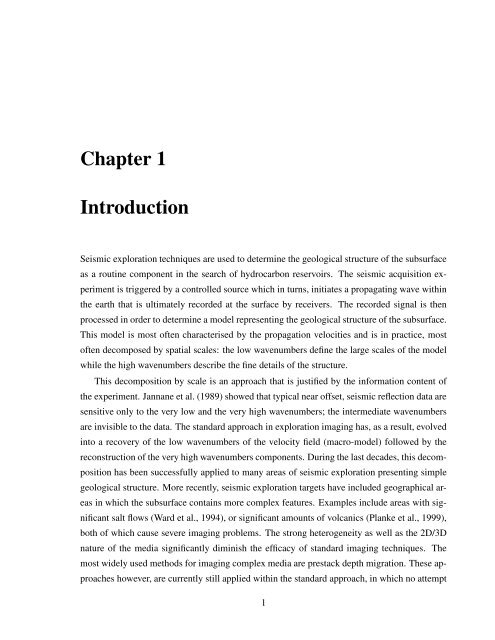Sirgue, Laurent, 2003. Inversion de la forme d'onde dans le ...
Sirgue, Laurent, 2003. Inversion de la forme d'onde dans le ...
Sirgue, Laurent, 2003. Inversion de la forme d'onde dans le ...
Create successful ePaper yourself
Turn your PDF publications into a flip-book with our unique Google optimized e-Paper software.
Chapter 1<br />
Introduction<br />
Seismic exploration techniques are used to <strong>de</strong>termine the geological structure of the subsurface<br />
as a routine component in the search of hydrocarbon reservoirs. The seismic acquisition experiment<br />
is triggered by a control<strong>le</strong>d source which in turns, initiates a propagating wave within<br />
the earth that is ultimately recor<strong>de</strong>d at the surface by receivers. The recor<strong>de</strong>d signal is then<br />
processed in or<strong>de</strong>r to <strong>de</strong>termine a mo<strong>de</strong>l representing the geological structure of the subsurface.<br />
This mo<strong>de</strong>l is most often characterised by the propagation velocities and is in practice, most<br />
often <strong>de</strong>composed by spatial sca<strong>le</strong>s: the low wavenumbers <strong>de</strong>fine the <strong>la</strong>rge sca<strong>le</strong>s of the mo<strong>de</strong>l<br />
whi<strong>le</strong> the high wavenumbers <strong>de</strong>scribe the fine <strong>de</strong>tails of the structure.<br />
This <strong>de</strong>composition by sca<strong>le</strong> is an approach that is justified by the information content of<br />
the experiment. Jannane et al. (1989) showed that typical near offset, seismic ref<strong>le</strong>ction data are<br />
sensitive only to the very low and the very high wavenumbers; the intermediate wavenumbers<br />
are invisib<strong>le</strong> to the data. The standard approach in exploration imaging has, as a result, evolved<br />
into a recovery of the low wavenumbers of the velocity field (macro-mo<strong>de</strong>l) followed by the<br />
reconstruction of the very high wavenumbers components. During the <strong>la</strong>st <strong>de</strong>ca<strong>de</strong>s, this <strong>de</strong>composition<br />
has been successfully applied to many areas of seismic exploration presenting simp<strong>le</strong><br />
geological structure. More recently, seismic exploration targets have inclu<strong>de</strong>d geographical areas<br />
in which the subsurface contains more comp<strong>le</strong>x features. Examp<strong>le</strong>s inclu<strong>de</strong> areas with significant<br />
salt flows (Ward et al., 1994), or significant amounts of volcanics (P<strong>la</strong>nke et al., 1999),<br />
both of which cause severe imaging prob<strong>le</strong>ms. The strong heterogeneity as well as the 2D/3D<br />
nature of the media significantly diminish the efficacy of standard imaging techniques. The<br />
most wi<strong>de</strong>ly used methods for imaging comp<strong>le</strong>x media are prestack <strong>de</strong>pth migration. These approaches<br />
however, are currently still applied within the standard approach, in which no attempt<br />
1

















